Day 57-60 – March 1-4
Osorno, Chile to San Carlos de Bariloche, Argentina to Los Alerces National Park, Argentina to Puyugapi, Chile
March 1
We got a late start out of Osorno and headed to Moto Aventura, the tour operator Helge had arranged to have our tires changed. We started the trip with knobby tires for Baja Mexico, changed to road tires, and now we will switch back to knobbies.
Without a center stand, switching tires on my bike requires lifting it into a 3-point stance (the points of support being the back tire, the kickstand, and a metal stand propped underneath the skid plate).
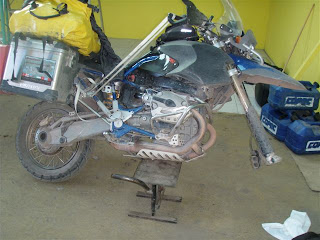
Changing the tires was made much easier by a machine that automatically breaks the bead on a tubeless tire and peels the tire from the rim.
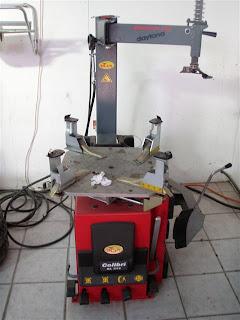
In the process of changing the front tire, I think I may have bent the kickstand which will need to be repaired later after I figure out a way to heat it, enabling it to bend more easily.
We rode through lovely farmland and could just make out a snow capped volcano in the distance:
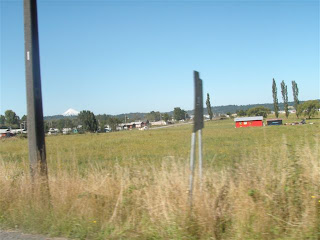
We passed some beautiful lakes. . .
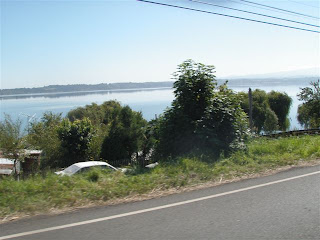
. . . and as we approached the Argentine border, spectacular mountains came into view:
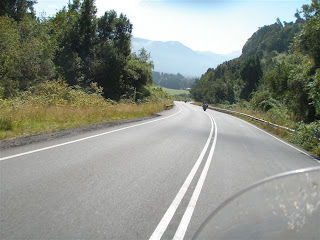
The border crossing was relatively easy—they only asked me to open two bags, which made me feel that my efforts to shave and dust off my motorcycle jacket were worthwhile.
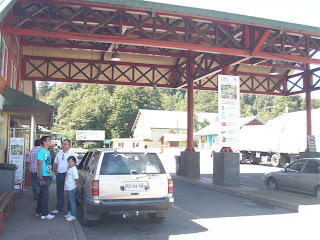
The ride to Bariloche was entirely on paved roads through a gorgeous park system. The outcropping you see here is the remnants of a volcano. The center peak is a column of hardened magma and the surrounding slopes have washed away over time:
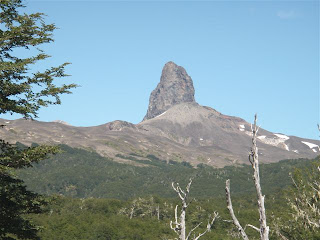
An explanation of the volcano’s current profile is provided on this plaque:

The road was serpentine, tucked closely alongside the mountain. . .

. . .with beautiful vistas.
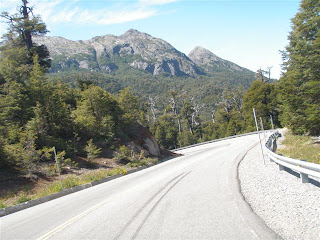
The poles alongside the road are high enough to still be seen when the area is covered in snow.
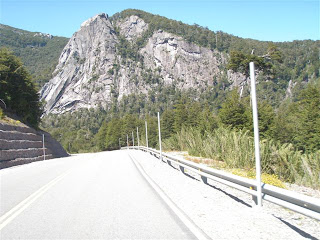
Bariloche sits beside a huge beautiful lake framed by the mountain range:
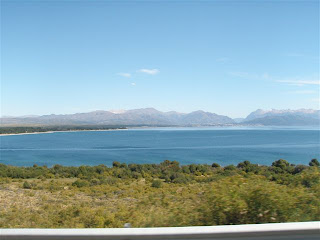
We had an enjoyable dinner:
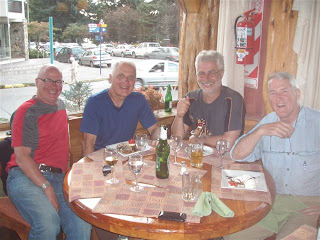
Helge managed to consume this entire plate of food:

The food here is hard to identify (as in China) – not sure if it is mammal or fish. But as Helge is a vegetarian (or, more accurately, a pescetarain), this meal was comprised solely of things from the sea (note the size of the octopus).
We hooked up with an entertaining real estate developer from San Diego who was in the Bariloche area for three months trout fishing and enjoying the hospitality of the Argentine women, who (he claims) have a love/hate relationship with Americans. He said that Bariloche was one of the top four fishing spots in the world. In one day, he caught nearly a hundred fish – he would cast and WHAM, a trout would hit the fly. The largest trout he caught was twenty-four inches long. Incidentally, he follows a “catch and release” policy for both the fish and the women.
Vince and Roger had brought along fishing gear and felt it imperative to stay an extra day to try out the waters.
Bariloche appears to be Argentina’s version of Aspen or Vail – it’s known as “little Switzerland.” I have never seen more chocolate shops – and they were all very busy. All of the shops were “high end” and I was able to replace my second lost Swiss Army knife.
I was surprised at the lack of activity on the lake in Bariloche. There were very few sailboats and only a few beaches – the lake provides more of a vista than an activity.
March 2
We stayed an extra day in Bariloche while Roger and Vince went fishing and Helge caught up on his correspondence. I spent the day shopping and drove up into the mountains to explore the local ski area and the dirt roads above the city.
Even though Bariloche is a small town, it is still in Argentina, and in Argentina CNG (compressed natural gas) is king.

I headed to the mountains and the ski area, which has many more amenities than were available in Portillo, Chile, but appears to lack some of the aggressiveness of the terrain.

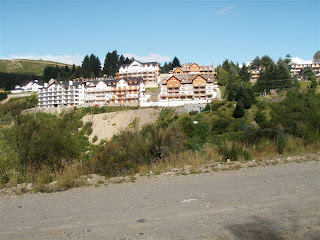
It was surrounded by beautifully forested mountains, but the ski area itself was much smaller than that of Aspen or Vail:
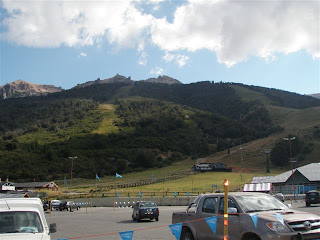
I found a trail which I followed for ten or fifteen miles down into a small village on the other side of the mountain. The sides of the road were framed with lush vegetation and steep, rough, craggy mountains:
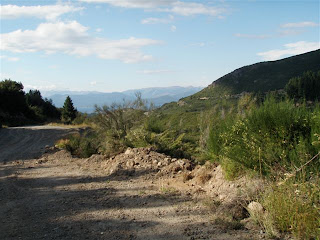
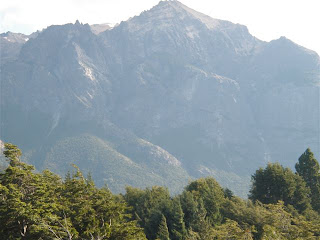
In spots in Bolivia, the tree line was at times higher than 14,000 feet, but as we have moved farther south, the tree line (influenced by snow and wind) is down to about 4,000 feet.
At the far end of the lake, I was disappointed to see a golf course (the first one we’ve seen in at least a month), but I guess you can’t have a version of Vail or Aspen without a golf course:

Passing through some of the small villages, I inspected some new construction. This small apartment complex is three stories of poured concrete—exactly the type of building that cannot handle a significant sideward motion, particularly when perched on a hill:

To give it added strength against collapse, this lightweight brick is used for the walls (but this has virtually no ductility and could break like glass):
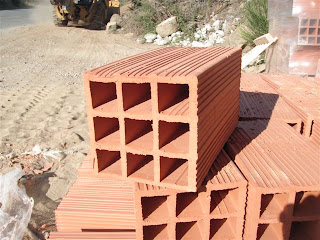
The largest areas of destruction in the recent Chile quake occurred in areas where they use mud bricks which have no strength at all and collapse very easily (particularly on steep slopes).
March 3
We got an early start out of Bariloche. . .
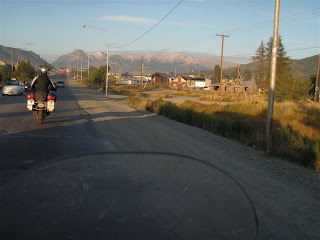
. . .and headed south on sealed roads through some beautiful country:
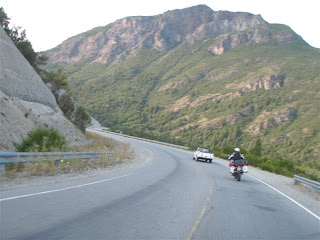
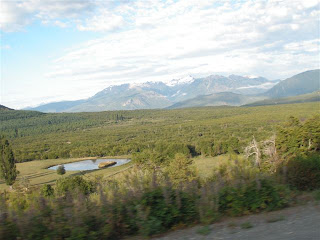
We’re still in vacation country, and some of the cottages are extremely homey—check out the flowers and pool by this small cottage:
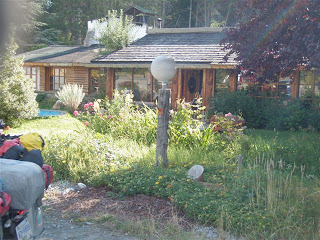
All around us were the snow-covered peaks of the Andes:
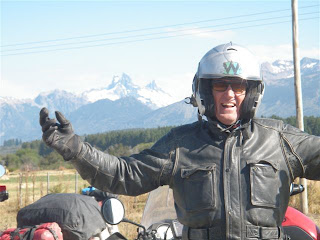
We passed farmers on horseback typically wearing either a large sombrero or a natty French beret:
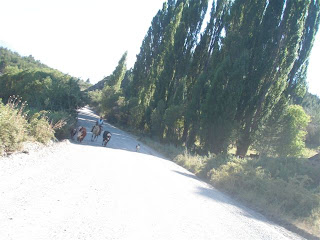
As we approached Los Alerces National Park, the trees closed in over the dirt road, forming a canopy:
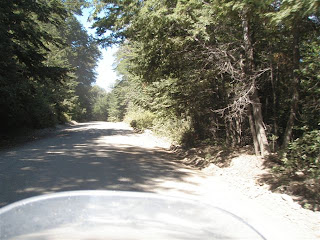
The park extends for roughly fifty miles and is dotted with streams and small farms within the park grounds:

Even though the road is rough and dusty. . .

. . .here you can see that Roger and Vince are loving the ride:
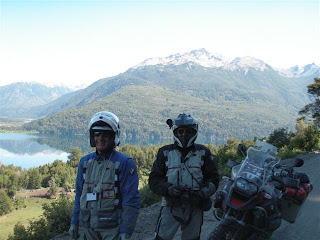
We picked an excellent campsite, and Helge set up to film us putting up our tents:

We ended up with a beautiful campsite with our bikes very near our tents (the better to hear you with!):
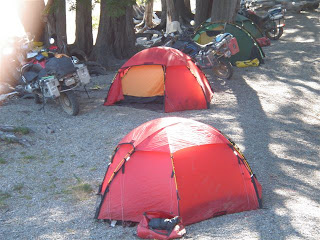
Here is the view from my tent:
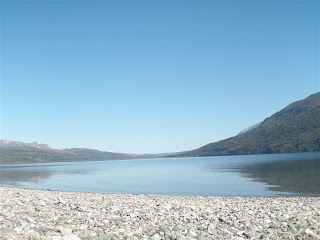
Helge, the vegetarian, bought Roger and me a frozen chicken, and we hung it from a rope in the lake to thaw, drawing the attention of a hawk:

We caught Helge in a classic “conflict of interest” situation: he was trying to get a good shot of the hawk at the cost of our dinner. As a compromise, we removed the giblets, cooked them up for additional flavor and hung them from a low tree in order to bait the hawk and hopefully provide better photographs. We were all positioned on the ground, patiently waiting to get the spectacular shot, but even with its thumb-sized brain, the hawk did a quick risk/reward analysis and flew away. In the last administration, it would have been good to have someone as wise as the hawk in weighing risk/reward relationships.
Roger and I split the chicken (the vegetarians ate potatoes and canned veggies—too bad for them).

Helge built a roaring fire with logs that are a foot in diameter. The fire burned throughout the night:

We slept extraordinarily well—much better than in a hotel or cabana.
March 4
We got a rather late start in the morning – no coffee, no breakfast – and headed south to Puyugapi.

The road was a mix of extremely dusty and rocky dirt roads . . .

. . . and nicer dirt roads (where we could go up to 60 mph):
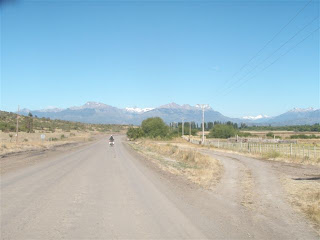
We traveled through agricultural valleys. . .


. . .with marginal grazing land:
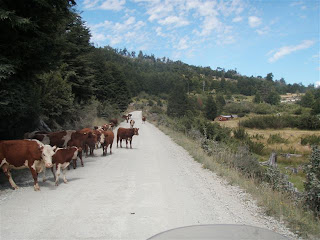
We crossed back into Chile and met a couple of Swedes at lunch on a nine-month holiday, modestly sponsored by BMW. When they return to Sweden, they will go on a lecture circuit to BMW dealers to promote adventure motorcycling and were able to obtain a modest sponsorship, even though they had never been on an adventure trip before.
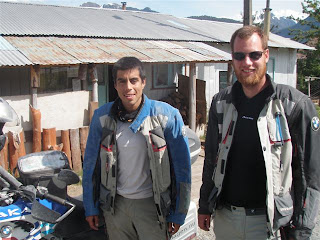
We stayed at a very nice youth hostel that had separate bedrooms but a shared bathroom. For a hostel it was a bit pricey: $60/person including breakfast. We met up with the Swedes for dinner, and motorcycle talk dominated the conversation.
Here are a couple of rather poor photographs of a standard Chilean suspension bridge:
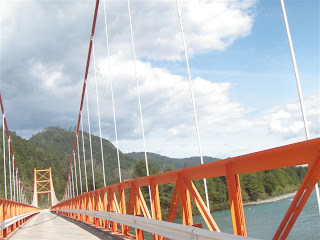

The bridge looks efficient and cheap and has a significant span. We have seen several of these—it’s clearly a bridge built to a formula. A similar bridge would look excellent connecting Wendy Park to the development of the West Flats spanning the old channel of the Cuyahoga.
Changing the tires was made much easier by a machine that automatically breaks the bead on a tubeless tire and peels the tire from the rim.
In the process of changing the front tire, I think I may have bent the kickstand which will need to be repaired later after I figure out a way to heat it, enabling it to bend more easily.
We rode through lovely farmland and could just make out a snow capped volcano in the distance:
We passed some beautiful lakes. . .
. . . and as we approached the Argentine border, spectacular mountains came into view:
The border crossing was relatively easy—they only asked me to open two bags, which made me feel that my efforts to shave and dust off my motorcycle jacket were worthwhile.
The ride to Bariloche was entirely on paved roads through a gorgeous park system. The outcropping you see here is the remnants of a volcano. The center peak is a column of hardened magma and the surrounding slopes have washed away over time:
An explanation of the volcano’s current profile is provided on this plaque:
The road was serpentine, tucked closely alongside the mountain. . .
. . .with beautiful vistas.
The poles alongside the road are high enough to still be seen when the area is covered in snow.
Bariloche sits beside a huge beautiful lake framed by the mountain range:
We had an enjoyable dinner:
Helge managed to consume this entire plate of food:
The food here is hard to identify (as in China) – not sure if it is mammal or fish. But as Helge is a vegetarian (or, more accurately, a pescetarain), this meal was comprised solely of things from the sea (note the size of the octopus).
We hooked up with an entertaining real estate developer from San Diego who was in the Bariloche area for three months trout fishing and enjoying the hospitality of the Argentine women, who (he claims) have a love/hate relationship with Americans. He said that Bariloche was one of the top four fishing spots in the world. In one day, he caught nearly a hundred fish – he would cast and WHAM, a trout would hit the fly. The largest trout he caught was twenty-four inches long. Incidentally, he follows a “catch and release” policy for both the fish and the women.
Vince and Roger had brought along fishing gear and felt it imperative to stay an extra day to try out the waters.
Bariloche appears to be Argentina’s version of Aspen or Vail – it’s known as “little Switzerland.” I have never seen more chocolate shops – and they were all very busy. All of the shops were “high end” and I was able to replace my second lost Swiss Army knife.
I was surprised at the lack of activity on the lake in Bariloche. There were very few sailboats and only a few beaches – the lake provides more of a vista than an activity.
March 2
We stayed an extra day in Bariloche while Roger and Vince went fishing and Helge caught up on his correspondence. I spent the day shopping and drove up into the mountains to explore the local ski area and the dirt roads above the city.
Even though Bariloche is a small town, it is still in Argentina, and in Argentina CNG (compressed natural gas) is king.
I headed to the mountains and the ski area, which has many more amenities than were available in Portillo, Chile, but appears to lack some of the aggressiveness of the terrain.
It was surrounded by beautifully forested mountains, but the ski area itself was much smaller than that of Aspen or Vail:
I found a trail which I followed for ten or fifteen miles down into a small village on the other side of the mountain. The sides of the road were framed with lush vegetation and steep, rough, craggy mountains:
In spots in Bolivia, the tree line was at times higher than 14,000 feet, but as we have moved farther south, the tree line (influenced by snow and wind) is down to about 4,000 feet.
At the far end of the lake, I was disappointed to see a golf course (the first one we’ve seen in at least a month), but I guess you can’t have a version of Vail or Aspen without a golf course:
Passing through some of the small villages, I inspected some new construction. This small apartment complex is three stories of poured concrete—exactly the type of building that cannot handle a significant sideward motion, particularly when perched on a hill:
To give it added strength against collapse, this lightweight brick is used for the walls (but this has virtually no ductility and could break like glass):
The largest areas of destruction in the recent Chile quake occurred in areas where they use mud bricks which have no strength at all and collapse very easily (particularly on steep slopes).
March 3
We got an early start out of Bariloche. . .
. . .and headed south on sealed roads through some beautiful country:
We’re still in vacation country, and some of the cottages are extremely homey—check out the flowers and pool by this small cottage:
All around us were the snow-covered peaks of the Andes:
We passed farmers on horseback typically wearing either a large sombrero or a natty French beret:
As we approached Los Alerces National Park, the trees closed in over the dirt road, forming a canopy:
The park extends for roughly fifty miles and is dotted with streams and small farms within the park grounds:
Even though the road is rough and dusty. . .
. . .here you can see that Roger and Vince are loving the ride:
We picked an excellent campsite, and Helge set up to film us putting up our tents:
We ended up with a beautiful campsite with our bikes very near our tents (the better to hear you with!):
Here is the view from my tent:
Helge, the vegetarian, bought Roger and me a frozen chicken, and we hung it from a rope in the lake to thaw, drawing the attention of a hawk:
We caught Helge in a classic “conflict of interest” situation: he was trying to get a good shot of the hawk at the cost of our dinner. As a compromise, we removed the giblets, cooked them up for additional flavor and hung them from a low tree in order to bait the hawk and hopefully provide better photographs. We were all positioned on the ground, patiently waiting to get the spectacular shot, but even with its thumb-sized brain, the hawk did a quick risk/reward analysis and flew away. In the last administration, it would have been good to have someone as wise as the hawk in weighing risk/reward relationships.
Roger and I split the chicken (the vegetarians ate potatoes and canned veggies—too bad for them).
Helge built a roaring fire with logs that are a foot in diameter. The fire burned throughout the night:
We slept extraordinarily well—much better than in a hotel or cabana.
March 4
We got a rather late start in the morning – no coffee, no breakfast – and headed south to Puyugapi.
The road was a mix of extremely dusty and rocky dirt roads . . .
. . . and nicer dirt roads (where we could go up to 60 mph):
We traveled through agricultural valleys. . .
. . .with marginal grazing land:
We crossed back into Chile and met a couple of Swedes at lunch on a nine-month holiday, modestly sponsored by BMW. When they return to Sweden, they will go on a lecture circuit to BMW dealers to promote adventure motorcycling and were able to obtain a modest sponsorship, even though they had never been on an adventure trip before.
We stayed at a very nice youth hostel that had separate bedrooms but a shared bathroom. For a hostel it was a bit pricey: $60/person including breakfast. We met up with the Swedes for dinner, and motorcycle talk dominated the conversation.
Here are a couple of rather poor photographs of a standard Chilean suspension bridge:
The bridge looks efficient and cheap and has a significant span. We have seen several of these—it’s clearly a bridge built to a formula. A similar bridge would look excellent connecting Wendy Park to the development of the West Flats spanning the old channel of the Cuyahoga.
Back to Top

Add A Comment